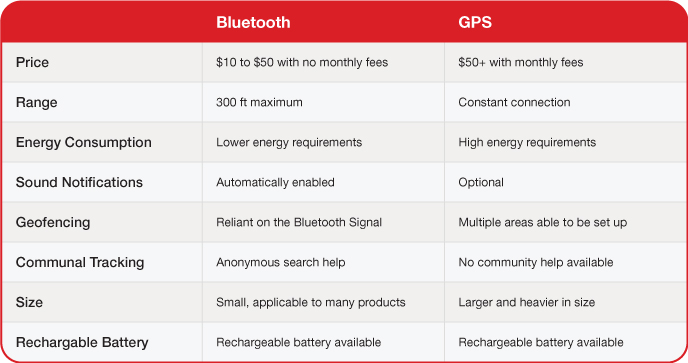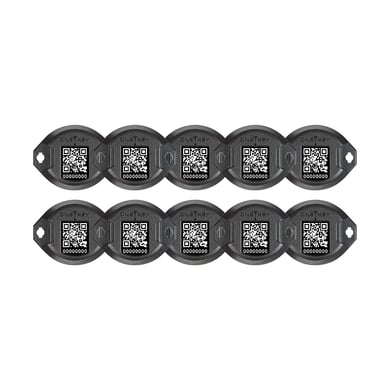Bluetooth vs GPS for Tool Tracking
Global Position System (GPS) and Bluetooth® have long been the heavy hitters in the item tracking game. But which is better for construction sites and keeping track of tools?
ONE-KEY™ uses Bluetooth® Low Energy (BLE) to help you keep track of your tools and equipment without draining your mobile device’s battery or requiring expensive hardware. In this article, we’ll outline some of the key differences between GPS and Bluetooth for tool and equipment tracking and inventory management needs.
Why Bluetooth tool tracking?
If and when, for whatever reason, you find yourself thinking about tracking systems, odds are a single three letter acronym jumps to mind. The Global Positioning System (GPS) has attained the status of a household name—shorthand for the technological wizardry your smartphone performs to help keep track of yourself and everything else in our complex world.
And yet there’s something else right at your fingertips that’s even better at getting the job done than GPS in certain situations. The last time you used Bluetooth, it was probably to wirelessly connect your phone to a headset or pair of speakers. But did you know you can also use it to track physical objects in your environment?
Bluetooth—specifically, Bluetooth Low Energy (BLE)—is what Milwaukee® uses to keep track of its state-of-the-art line of One-Key enabled tools both on and off the jobsite. It’s also the wireless smartphone tech that undergirds of Milwaukee tracking hardware products.
For example, the TICK™ tracker, first announced in 2017, debuted as a long-life, heavy-duty, durable tool and equipment tracker—e.g., weather, dust, and water-resistant—that can be attached to any item, and monitored on the One-Key digital platform. Recently released, the One-Key Bluetooth Tracking Tag adds even more advanced tracking functionality and a wider tracking range.
Further reading: Learn the differences between the TICK vs the Bluetooth Tag vs an Asset ID Tag.
So why use Bluetooth instead of GPS? The short answer: Just like with anything else, you have to choose the right tool for the job. You wouldn’t use a circular saw where a boxcutter would do the trick. GPS is perfect for certain situations, but for the purposes of tracking the most important tools in your inventory, Bluetooth is the better way to go.
Here’s why.

Bluetooth is short range
This might seem like a serious downside at first. How could it be a good thing that Bluetooth tracking only works within about a 100-foot range, whereas GPS can work over long distances?
On closer examination, it turns out not only is this a good thing, but the comparatively short range of Bluetooth is one of its greatest strengths.
Try doing anything on your smartphone in an area without wi-fi or cellular signal and you’ll understand the problem. GPS’s functionality depends entirely on your smartphone’s ability to establish a strong connection to a network of more than two-dozen satellites in orbit around the globe. This can be a real obstacle if you’re working on a jobsite that’s off the beaten path, or if the item you’re tracking ventures into an area that’s beyond the reach of the GPS network.
This isn’t an issue for Bluetooth. No celestial infrastructure required. Relying instead on short range radio frequencies transmitted and received by localized devices, Bluetooth allows users to create small, ad hoc wireless networks wherever you go.
![]()
Connecting more devices and trackable items increases the range and capacity of these ad hoc networks, as is the case with Milwaukee’s One-Key tool tracking system.
Bluetooth is better for your battery
It’s just a fact that GPS powered apps drain the batteries of smart devices at a faster rate than Bluetooth. The GPS on your phone works by constantly having to search for and maintain connections with cell towers. Even if the signal is strong, this can lead to about 13% battery depletion—climbing up to almost 40% if the signal is weak.
While using any feature of your phone will have some drain on its battery, with Bluetooth as no exception, One-Key uses a kind of Bluetooth called Bluetooth Low Energy (BLE) specifically with optimal performance in mind. Introduced as an update in 2011, BLE is a version of Bluetooth that—you guessed it—uses less energy.
![]()
BLE is ideal for networking multiple low output devices in the Internet of Things (IoT), facilitating the transmission of small amounts of data, which is all that is required in the field when tracking the locations of your tools. You don’t need to download anything. BLE is already part of your smart device’s Bluetooth functionality.
What’s more, the Bluetooth trackers themselves have a longer battery life. For example, the TICK is powered by a single coin cell lithium ion battery that requires no recharge and will last at least a year, if not longer, giving the tracker a slim and lightweight profile that fits in the palm of your hand.
![]()
The One-Key Bluetooth Tracking Tag, on the other hand, uses a non-replaceable high-performance internal battery that's good for 3-years—eliminating cumbersome maintenance, while also coming in a smaller package (30% smaller) for an even lower profile and versatile attachment options. Plus, additional onboard tech improves its tracking capabilities:
- NFC and a scannable QR code offering a simpler 2-step activation process.
- A built-in speaker makes finding even easier; you can ring your tracker when it’s not physically visible, or use the last-100ft tracking experience proximity tool.
-
Accelerometer provides information on the last time equipment was used.
- 300ft Bluetooth range, or 3X greater range than the TICK.
![]()
GPS trackers, on the other hand, are typically bulkier, powered by larger batteries that need to either be replaced or recharged once a week.
GPS doesn’t have an answer to the battery problem yet. Bluetooth, on the other hand, does.
Bluetooth trackers are more affordable
Search online for a GPS tracker and you’ll see a lot of pricetags ranging from $50 to $150. Sometimes even higher. Meanwhile, the retail price for a Milwaukee TICK—as is the case for most Bluetooth trackers on the market—is about $25. Adding an additional $5 for a One-Key Bluetooth Tracking Tag gets you considerably more tracking functionality, or you can buy them in bulk (available in 2- and 10-packs).

The price difference might not seem like much at first, but if you want to track a large inventory of items, those extra dollars add up fast. That doesn’t acknowledge, either, that other GPS and Bluetooth inventory trackers aren’t built to withstand inclement weather and harsh environments that your tools and equipment are regularly exposed to.
![]()
Bottom line: Bluetooth Low Energy tracking systems like One-Key are more affordable, have more longevity, and are more versatile than the Global Positioning System. Overall, GPS of course has its strengths, primarily that it can track objects over much longer distances. But what good is that if the battery on your bulky and expensive GPS tracker dies the moment you need it most, or if you’re just in an area with bad cell phone reception?
Simply put, Milwaukee uses Bluetooth because it’s the right tool for the job. Again: Why use a circular saw when a boxcutter will do the trick?